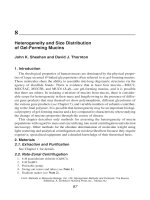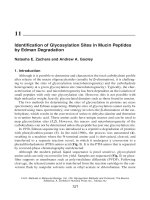Glycoprotein methods protocols - biotechnology 048-9-439-452.pdf
Bạn đang xem bản rút gọn của tài liệu. Xem và tải ngay bản đầy đủ của tài liệu tại đây (225.18 KB, 14 trang )
Mucin Degrading Bacteria in Biofilms 439
439
36
Growth of Mucin Degrading Bacteria in Biofilms
George T. Macfarlane and Sandra Macfarlane
1. Introduction
Mucins are important sources of carbohydrate for bacteria growing in the human
large intestine. As well as being produced by goblet cells in the colonic mucosa, sali-
vary, gastric, biliary, bronchial, and small intestinal mucins also enter the colon in
effluent from the small bowel. Particulate matter, such as partly digested plant cell
materials, are entrapped in this viscoelastic gel, which must be broken down to facili-
tate access of intestinal microorganisms to the food residues. It is estimated that
between 2 to 3 g of mucin enter the large bowel each day from the upper digestive tract
(1), however, the rate of colonic mucus formation is unknown. Complex polymers,
such as mucin must be degraded by a wide range of hydrolytic enzymes to smaller
oligomers and their component sugars and amino acids before they can be assimilated
by intestinal bacteria.
Pure and mixed culture studies have established that in many intestinal bacteria,
synthesis of these enzymes, particularly β-galactosidase, N-acetyl β-glucosaminidase,
and neuraminidase (2–4), is catabolite regulated, and is therefore dependent on local
concentrations of mucin and other carbohydrates. Although some colonic microorgan-
isms can produce several different glycosidases, which allows them to completely
digest heterogeneous polymers (5–8), the majority of experimental data points to the
fact that the breakdown of mucin and other complex organic molecules is a coopera-
tive activity.
In the large bowel, bacteria occur in a multiplicity of different microhabitats and
metabolic niches, on the mucosa, in the mucous layer, and in the colonic lumen, where
they exist in microcolonies, as free-living organisms, or on the surfaces of particulate
materials (9,10).
Wherever there are surfaces, bacteria form biofilms. They are usually complex
microbial assemblages that develop in response to the chemical composition of the
substratum and other environmental constraints. The available evidence shows that in
the colon, these microbiotas are heterogeneous entities that form rapidly on the sur-
From:
Methods in Molecular Biology, Vol. 125: Glycoprotein Methods and Protocols: The Mucins
Edited by: A. Corfield © Humana Press Inc., Totowa, NJ
440 Macfarlane and Macfarlane
faces of partly digested foodstuffs in the intestinal lumen, and in the mucous layer
covering the mucosa (9). Sessile microorganisms in biofilms often behave very differ-
ently from their nonadherent counterparts, and, in particular, the nature and efficiency
of their metabolism may be changed (10–12). Close spatial relationships between bac-
terial cells in biofilms are ecologically important in that they minimize potential growth
limiting effects on crossfeeding populations (13).
Although the large gut is often likened to a continuous culture system, this is an
oversimplification. Consideration of colonic motility and the way in which intestinal
material is processed suggests that only the cecum and ascending colon exhibit char-
acteristics of a continuous culture. The inaccessibility of the large bowel for experi-
ments on the digestion of mucin by colonic microorganisms inevitably means that the
majority of studies are made in vitro. A variety of models are available that enable
pure and mixed populations of intestinal bacteria to be grown under anaerobic condi-
tions, ranging from small screw-capped or serum bottles to more complex batch and
continuous fermentation systems (chemostats).
The effectiveness of in vitro model systems varies depending on the problem to be
investigated, and each method has advantages and disadvantages. For example, fer-
mentation experiments made using serum bottles are inexpensive, allow screening of a
number of substrates and/or fecal samples from different individuals, and require small
amounts of substrate and test sample (14). Depending on bacterial cell numbers, the
experiments can be designed to be of short duration, thereby minimising potential
distortions in the data resulting from the selection of nonrepresentative populations of
microorganisms. Longer-term experiments effectively become enrichment cultures,
selecting bacteria that are most efficient at utilizing the test substrates.
However, these fermentations are uncontrolled, and yield little information on bac-
terial metabolism, the organisms involved, or how the processes are regulated. The
limited data provided by such experiments relate simply to the input of substrates and
the output of products. Other problems may also be encountered; for example, if high-
substrate concentrations are used, strong nonphysiological buffers are needed to con-
trol pH, which may have unpredictable effects on bacterial metabolism. If culture pH
is not regulated, the environment in the vessel will change rapidly such that the fer-
mentation conditions become physiologically irrelevant.
Another factor to be considered with batch fermentations is that they are closed
systems, in which bacterial metabolic activities and environmental conditions in the
cultures are constantly changing. Thus, at the beginning of bacterial growth, substrate
concentrations are high, and become depleted as the cells grow, whereas bacterial
fermentation products and other autoinhibitory metabolites progressively accumulate
in the culture.
Many of these problems are avoided in continuous cultures, since they are open
systems that work efficiently at high bacterial population densities. Cell growth is
strictly controlled by the concentrations of limiting nutrients in the feed medium. For
this reason, the organisms grow suboptimally at specific growth rates (µ) set by the
experimenter, through alterations in dilution rate (D), which is regulated by varying
the rate at which culture medium is fed to the fermentation vessel.
Mucin Degrading Bacteria in Biofilms 441
The principal advantage of the chemostat in physiologic and ecologic studies on
microorganisms is that it enables long-term detailed investigations to be made under a
multitude of externally imposed steady-state conditions that are not possible with
closed batch-type cultures. A two-stage continuous culture model can be used for
studying the formation of mucin-degrading biofilms under nutrient-rich and nutrient-
depleted conditions. The system comprises paired glass fermentation vessels fitted
with modified lids (Fig. 1), and several extra sampling ports fitted to the vessel sides
to which removable mucin baits or mucin gel cassette holders (Fig. 2) are attached.
The fermenters are connected in series, with fresh culture medium being fed to ves-
sel 1 (V1), and spent culture from this vessel being pumped into vessel 2 (V2). This
facilitates the study of mucin colonization under relatively carbohydrate-rich V1 and
extremely carbon-limited (V2) environmental conditions, comparable to the proximal
and distal colons.
Three main protocols are outlined in this chapter for studying (1) mucous-degrad-
ing bacterial consortia occurring in biofilms on the rectal mucosa, (2) mucinolytic
species growing in artificial mucin biofilms in continuous culture models of the colon
in the laboratory, and (3) mucinolytic microorganisms colonizing the surfaces of food
particles in fecal material.
Methods outlined for the isolation of bacteria from the rectal mucosa are essentially
destructive, and primarily provide details of the types and numbers of different species
that take part in this process. They do not contribute information concerning the mul-
ticellular organization of biofilm communities. However, the chemostat modeling pro-
tocols afford useful comparative data on the enzymology and physiology of the
breakdown of mucin by adherent (mucin baits) and planktonic bacterial communities,
under varying environmental conditions, while the use of mucin-coated glass slides
attached to cassettes facilitates microscopic examination of biofilm development.
2. Materials
1. Samples for scanning electron microscopy (SEM) are placed in 3% (v/v) glutaraldehyde
in 1 M PIPES buffer, pH 7.0. Then fix the samples with 4% (w/v) aqueous OsO
4
, dehy-
drated stepwise in ethanol, which involves three changes (10 min) in each of 50, 75, 95,
and, finally, 100% ethanol. Then dry the samples on a Poleron E 5000 critical-point drier,
place on stubs, and gold-coat to a depth of 30 nm.
2. Glass tubes, mucin gel cassettes, and fermentation vessels for baiting studies are manu-
factured by Soham Glass, Ely, Cambs, UK.
3. All formulated bacteriologic culture media and growth supplements are supplied by
Oxoid. Use as per manufacturer’s instructions. Unless stated otherwise, all chemicals are
obtained from Sigma Aldrich Ltd. (Poole, UK). Agars for isolating specific bacterial
groups in mucin-degrading consortia are as follows:
a. Nutrient agar (total facultative anaerobes).
b. MaConkey agar no. 2 (lactose-fermenting and nonlactose-fermenting enterobacteria,
enterococci).
c. Azide blood agar base (facultative anaerobic cocci, some Gram-positive anaerobic
cocci).
d. Wilkins-Chalgren agar (total anaerobe counts).
442 Macfarlane and Macfarlane
e. Wilkins-Chalgren agar plus nonsporing supplements (nonsporing anaerobes). The
supplements contain hemin, menadione, sodium pyruvate, and nalidixic acid.
f. Wilkins-Chalgren plus Gram-negative supplements (Gram-negative anaerobes). The
selective agents in this culture medium are hemin, menadione, sodium succinate,
nalidixic acid, and vancomycin.
g. MRS agar (lactobacilli).
h. Perfringens agar and supplements (Clostridium perfringens and certain other
clostridia). The selective supplements (A and B) contain sulfadiazine, oleandomycin
phosphate, and polymyxin B. All antibiotic additions are added at 50°C after auto-
claving for 121°C at 15 min.
Fig. 1. Two-stage continuous culture model used to study mucin-degrading biofilms under
carbon-excess (vessel 1, left) and carbon-limited (vessel 2, right) conditions.
Mucin Degrading Bacteria in Biofilms 443
i. Fusobacterium agar (fusobacteria). This comprises: 37.0 g/L Brucella agar base, 5.0
g/L Na
2
HPO
4
, 1.0 g/L NaH
2
PO
4
, 1.0 g/L MgSO
4
·7H
2
O, 0.005 g/L hemin, at pH 7.6.
This is autoclaved, cooled to 50°C and the following antibiotics are then added after
filter sterilisation in 5 mL distilled water: 20 mg/L neomycin, 10 mg/L vancomycin,
6.0 mg/L josamycin (ICN Biomedicals, Aurora, Ohio).
j. Beerens Agar for selective isolation of bifidobacteria is made as follows: 42.5 g/L
Columbia agar, 5.0 g/L glucose, 0.5 g/L cysteine HCl, 1.5 g/L purified bacteriologic
agar. Five milliliters of propionic acid is added to these constituents, after they have
been boiled and cooled to 70°C. The pH of the medium is then adjusted to 5.0 before
pouring the agar into Petri plates.
Fig. 2. Mucin gel cassette used for investigating bacterial colonization of mucous surfaces
in continuous culture experiments. The glass frame contains several slots into which are fitted
removable mucin-coated glass plates or microscope cover slips.









